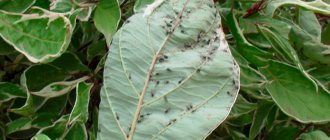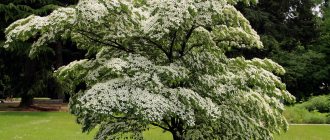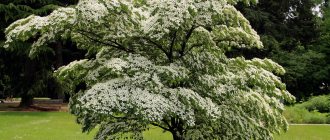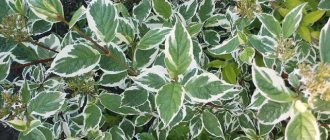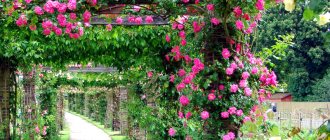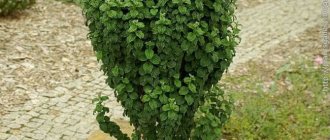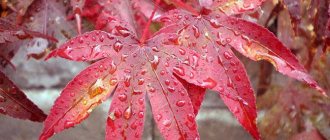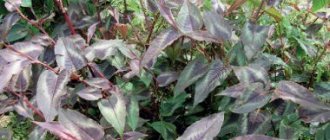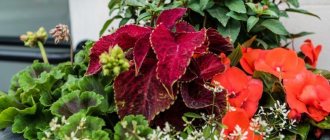Red dogwood, or blood-red dogwood, grows well in shady forests and bushes. Plant this plant in an area where light-loving flowers do not do well, and your shady corner will play with bright colors all year round.
This unusual shrub is famous for its very durable, brightly colored wood. Strong shoots can withstand gusty winds and do not break under the weight of snow. Derain attracts attention all year round, but it is in winter that he transforms the garden beyond recognition.
Description of redwood
Blood red turf belongs to the Dogwood family. In nature, turf reaches 4 m, grows in temperate climates, and is often found at the edge of forests and along the banks of reservoirs.
Description of blood-red deren:
- Flexible young shoots of derain are painted in a bright olive color. Over time, they change it to reddish or brown, and in late autumn, after the leaves fall, the shoots become bright burgundy;
- The ovate, dark green leaves are large, reaching 5 cm in diameter. In the first half of September, the leaf blade becomes blood-scarlet or brick-colored;
- at the end of spring, small creamy-snow-white flowers appear on the red deer, which remain on the branches for a month;
- the first inflorescences appear at the 7th year of life;
- with proper care and in regions with a warm climate, the plant can bloom again at the end of summer;
- in autumn, small, inedible black fruits are formed from the inflorescences;
- fast-growing shrub; within a year the crown grows up to half a meter in height and width;
- in one place the plant grows up to 25 years.
Red-leaved turf is cold-resistant and grows well in cities with an unstable climate. The plant also tolerates minor drought and can grow in the southern regions.
How to care?
Shrub care is easy. If the summer is hot and dry, it needs weekly watering. If the tree is not watered on time, the foliage may fade and become limp. When watering is resumed, the turf revives again. The main thing is not to skip watering so often. If the weather is normal and the sun alternates with rain, then there is no need to water it.
The shrub does not need special fertilizing or frequent fertilizers, but they will also be useful for it. There are still other trees growing on the site that require more careful care, and you can also feed the turf along with them. It is believed that derain is resistant to diseases and pests. Therefore, it does not need numerous preventive sprays, except perhaps in the fall and spring (together with other shrubs).
Blood red dogwood in landscape design
Red turf has a developed root system and a large number of lateral roots, due to which it is used to strengthen slopes.
The miniature red shrub looks attractive in any season, both in single and mass plantings. It is planted next to unattractive buildings and used to decorate shady corners, adding colorful colors to a nondescript winter area.
Red turf is grown as a hedge; it is unpretentious, easy to care for, and grows well in polluted areas.
Advice! Red-trunked turf grows well in moist soil and looks great near bodies of water.
Varieties of red turf
Red dogwood has become popular among flower growers since ancient times. Anyone can choose the most suitable variety for themselves:
- Compress;
- Midwinter Fire;
- Anna Winter Orange.
To quickly decide on the variety, you need to carefully read the description and look at the photo of the red tree.
Derain red Compress
The most popular, unusual variety. It received the love of flower growers for its compact shape, erect shoots and beautiful leaves. Glossy leaf plate of dark emerald color with small wrinkles.
The decorative value of the tree is increased by changing the color. In autumn, after leaf fall, the shoots turn blood red. The variety does not bloom, but this is not considered a drawback, since even without inflorescences, the plant does not become less attractive.
Blood-red dogwood Compressa is a small shrub that grows from 1 to 2 m in height. The crown is dense, compact, slow-growing. The annual growth is several cm per year.
The plant is shade-tolerant and can grow in shade and partial shade. For good growth and development, it needs alkaline, drained soil without stagnant water. Derain Kompressa is unpretentious in cultivation and care, so even a novice gardener can grow an attractive shrub.
Advice! Derain Compress looks good on alpine hills, among conifers and ornamental plants, as well as in flower beds.
Red Derain Midwinter Fire
An upright, spreading, low-growing variety reaches a height of up to 2 m. The shrub is frost-resistant, withstands temperatures down to -34 degrees.
The variety is decorative especially in winter. In autumn the shoots turn yellow and the ends orange-red. The broadly elliptical foliage is arranged oppositely and changes color from bright green to yellow-orange in the fall. Snow-white, fragrant corymbose inflorescences appear in early June and last for about a month. After flowering, dark-gray fruits are formed that look beautiful against the backdrop of snow-white snow.
Advice! The variety is unpretentious, so it grows well in sunny areas and in partial shade.
Looks good in flower beds, on an alpine hill and as a hedge.
Derain blood red Anna Winter Orange
A decorative, spreading variety reaches a height of up to 2 m. In summer, light orange shoots are covered with bright emerald foliage and snow-white hemispherical inflorescences up to 5 cm in diameter. After flowering, white-blue drupes are formed.
In autumn, the leaf blade acquires a rich orange color, and after the leaves fall, bright scarlet shoots are exposed, which decorate the garden plot in the autumn-winter period.
Blood-red dogwood Anny's Winter Orange is unpretentious and grows well in the shade on moist sandy loam soil.
Indoor garden astilbe - queen of shadow
Astilbe cannot be called a houseplant. It is transferred into pots only conditionally and grown only for six months for the sake of luxurious flowering. Any indoor astilbe will have to be planted in the soil for rest, but each bush can be used more than once to force luxurious inflorescences.
Astilbes appear on the shelves of flower shops on the eve of winter, but the largest selection of forcing plants can be found between the winter holidays and spring.
Astilbes are surprisingly spectacular and versatile plants from the Saxifraga family. In terms of the type and abundance of flowering, no other beautifully flowering garden crop can compete with them. And the fact that astilbe prefers to grow in shade makes this perennial even more unique. Astilbes are included in all TOP garden perennials with beautiful flowering.
As a houseplant, astilbe is a seasonal decoration, a spectacularly blooming analogue of “living bouquets”, which is driven out to bloom at certain times, and then planted in open soil. It remains a perennial, but requires growing in more than just pots.
This status greatly complicates the growing process and limits its distribution: not all gardeners can afford to plant astilbe in a shady flower garden after an indoor season. Of course, you can simply throw away the plant after flowering. But since we are talking about valuable and luxurious long-lasting perennials, it is better to grow astilbe as a garden crop.
What does astilbe look like?
Astilbe's appearance is regal. This is a hardy, unpretentious, decorative plant both in terms of foliage and flowering. Triple or double dissected, reminiscent of luxurious lace, with a filigree jagged edge on the lobes, the leaves are colored in a rich green tone and look festive in themselves.
The glossy surface of carved astilbe leaves seems amazing for their texture and ornamentation, further emphasizing the beauty of the greenery. Actually, the plant received its specific name (from the Greek “very shiny”) for the beauty of the leaves and their shiny surface. The leaves of the plant only partially resemble a fern, and even then rather in their shade of color.
Astilbes in nature and gardens are capable of producing inflorescences up to 2 m high. In indoor culture, these are half-meter-high, compact, spectacular bushes. Even when choosing ordinary varieties of garden astilbes, the maximum height of peduncles is limited to 60 cm. When choosing the right planting material, astilbes create very elegant, dense, evenly leafy bushes with a diameter of about 40 cm, which look voluminous and lush.
Astilbe inflorescences in the form of paniculate racemes are easily recognizable. In the indoor format, the brightest and most unusual varieties are used; often the inflorescences of plants presented in flower shops show off not straight, but drooping shapes. Thousands of small, barely visible astilbe flowers are collected at the tops of the stems in complex clusters of inflorescences, resembling a thick fur brush. The fluffy, weightless effect of the inflorescences is enhanced by their pure color, which includes different variations of white and cherry tones with beautiful pastel shades of pink and red tones.
The timing of astilbe flowering in gardens coincides with the peak of the season - mid-summer. In indoor culture, astilbe is a winter-flowering plant, which is planted specifically for flowering in mid-late winter or for the first spring holidays.
When growing astilbe in a room, it is better to give preference to small containers. Cliff
Planting and caring for red dogwood
To grow a beautiful, spreading shrub, you need to take into account the characteristics of the plant. The red bush is not picky about the planting site and soil quality. To obtain the maximum visual effect, it is necessary to regularly water, fertilize and pruning.
Landing rules
It is better to plant the red derain shrub in a sunny place or in partial shade, since in the shade the shoots lengthen, the leaf blade fades, and as a result the plant loses its decorative appearance. Red turf prefers nutritious, well-drained soil with neutral acidity.
Planting technology:
- Seedlings are planted in the spring, after the end of frost, or in the fall a month before the onset of frost.
- If the planting material has an open root system, before planting, the roots are trimmed and kept in warm water for 4-5 hours. If the seedling was purchased in a container, it is placed in a planting hole with a lump of earth.
- A hole is dug measuring 50x50, at a distance of 0.7 m from each other.
- A 15 cm layer of drainage is poured onto the bottom.
- The seedling is placed in the center and carefully sprinkled with earth, compacting each layer.
- The soil is shed generously and mulched.
Important! If the soil is depleted, humus, compost or rotted manure is added to the planting hole.
Watering and fertilizing
The red-stemmed tree is drought-resistant. Does not require a special watering schedule. The first abundant watering is carried out after planting the seedling, further watering is carried out as necessary. If the foliage has lost turgor and shriveled, then this is the first sign of lack of moisture.
Fertilizing affects the decorativeness of the plant. Complex mineral fertilizers, such as “Nitrophoska”, “Ammophos”, are applied in the spring, before the leaves bloom, strictly following the dosage rules.
Thanks to proper and timely feeding, the turf:
- produces bright shoots and leaves;
- forms a dense, spreading crown;
- blooms a large number of flowers.
Trimming
To add decorativeness, it is necessary to remember about pruning, since the shoots lose their elasticity and color with age, the crown quickly grows in width, thereby giving the plant an untidy appearance.
The first pruning is carried out several years after planting. Old branches are removed in the spring, leaving stumps of 10-15 cm. At the end of summer, the crown of the tree is formed, weakened and underdeveloped branches are cut out. To prevent the appearance of fungal diseases, the cut area is covered with charcoal or brilliant green.
Advice! In order for the red bush to look aesthetically pleasing and neat, it is necessary to remove the root shoots.
Preparing for winter
Red derain is cold-resistant, can withstand temperatures down to -34 degrees, so it does not need shelter. In regions with cold, little snow winters, only young seedlings are covered.
How to plant?
To ensure that the shrub grows well, is bright and has a lush crown, it is recommended to choose places for planting where there is a lot of sun. In the shade, the plant, of course, will not die, but in beauty it will lose to its fellows growing in the light.
The red-leaved shrub looks especially advantageous against a background of contrasting color. This could be a fence made of gray stone, coniferous trees that grow nearby.
The first two to three years the tree grows a little, but intensive growth begins after three years. Then you can start forming the crown.
In order for the planting to be successful and the tree to take root well, you need to add compost to the soil. Before planting, the seedling is placed in a bucket of water for a couple of hours, the roots will straighten out and be well moistened.
Dig a hole at least half a meter deep. If the soil is too wet, stones and sand are placed at the bottom to provide good drainage. After planting, the tree should be watered regularly as the soil dries out.
The shrub can be planted both in autumn and spring. The main thing is to do this in the fall before the first frost, so that the tree has time to take root. In spring, the adaptation period passes faster.
Reproduction
Red turf can be propagated in several ways:
- seeds;
- cuttings;
- dividing the bush;
- bends.
All methods are easy to implement, the survival rate is about 90-100%.
Seeds
Seed material is purchased at the store or collected from the bush you like. In order for the germination of seeds to be high, they must undergo stratification. Therefore, they are sown in the fall in a prepared place. Furrows are made in the area, 5 cm deep, seeds are laid and sprinkled with earth.
After the emergence of seedlings, thinning is done. After 4 years, when the turf reaches 80 cm, it is replanted.
Cuttings
A simple way to propagate redwood. Cuttings are cut in mid-summer, 10-15 cm long. The lower leaves are removed, the upper ones are cut by ½.
The prepared seedling is kept in a growth stimulator for several minutes and planted in nutrient soil to a depth of 10 cm, at an angle of 45 degrees. The cuttings are shed generously and placed in a mini-greenhouse, which must be regularly ventilated. The air temperature for germination should be +23-25 degrees. In the fall, after the roots have grown, the turf is transplanted to a permanent place.
Important! In the first winter, the seedling is covered with burlap, spunbond or lutrasil.
By layering
Young side shoots are suitable for this method. The procedure is carried out in the spring, after the snow melts. A healthy shoot is placed in a prepared trench, fixed to the ground with a metal bracket and sprinkled, leaving the top on the surface. The soil is mulched with sawdust, straw or leaves.
After new foliage appears, the young seedling is disconnected from the mother bush and transplanted to a prepared area.
Dividing the bush
For this method, an adult bush that requires replanting is selected. In the fall, the turf is dug up and divided into sections so that each plant has an overgrown root system and healthy shoots.
The cut site is treated with charcoal, and the plant is transplanted to the prepared area.
